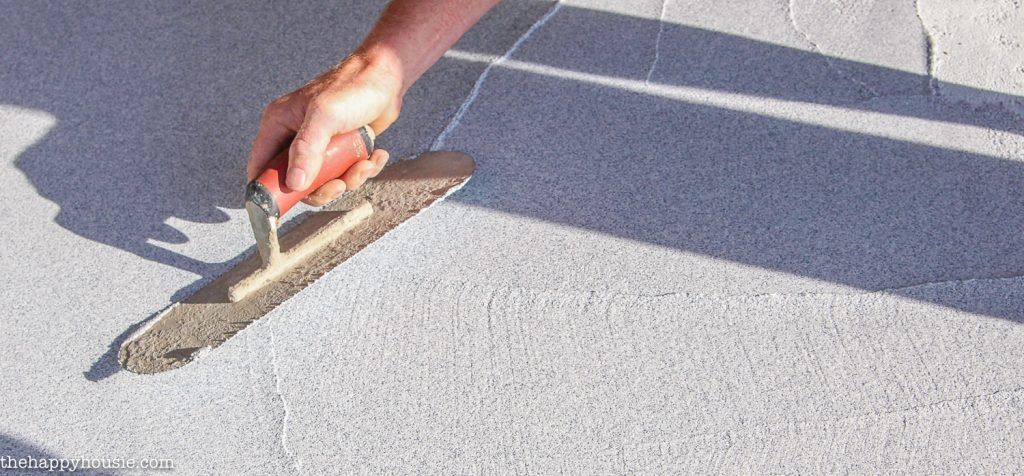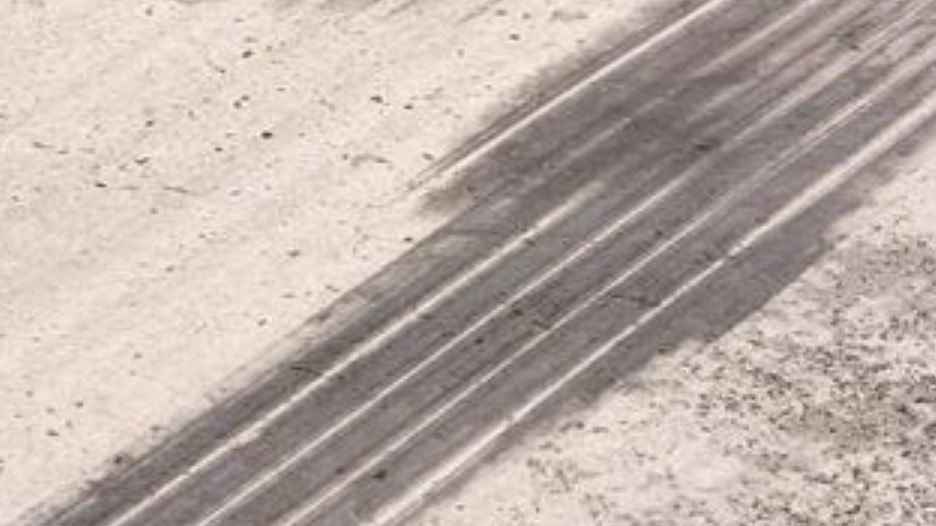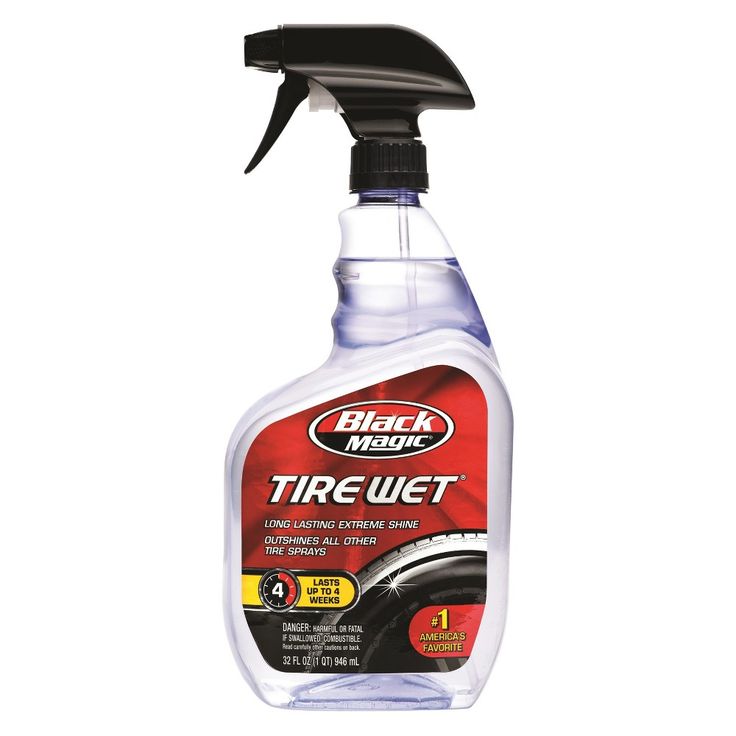Do you have four half-moon stains on your concrete or paved driveway? The main ingredient in tire shine products is silicone, an element with very similar properties to carbon.
Tires are made of natural and synthetic rubber (long carbon chained molecules) mixed with carbon and Sulphur to produce rubber. Some anti-oxidants are also incorporated into the rubber to prevent the rubber from oxidizing.
Getting rid of tire stains caused by the silicone or carbon-based oils in tire cleaners can best be done by using muriatic acid and water to dissolve and wash away the embedded oil. A propane flame is also very effective in burning off the oil and tire cleaner residue on your driveway.
There are many homemade or commercially available tire shine products on the market. The tire shine creates a thin protective layer of carbon or silicone molecules on the surface of the sidewall of the tires, giving them a shiny black appearance.
The application of tire shine products creates overspray on driveways, causing unsightly discoloration. Let’s look at some ways to avoid getting the driveway dirty and how to clean up stains on driveways caused by tire shine overspray.
Silicone is the most common active ingredient in commercially available tire shine products. The silicone-based liquid is often applied with a spray bottle or in an aerosol mist.
Silicone is also used in concrete surface sealants and bonds very well to porous concrete. The white stains left by tire shine are the silicone clogging up the surface layer of the concrete.
To prevent stains on your concrete driveway, tire detailing should not be done on your driveway. Parking your car on the lawn will ensure that the soapy water and other dirt washed off the car and tires will be absorbed by the soils and broken down by biological processes.
Parking your car on the lawn will ensure that the soapy water and other dirt washed off the car and tires will be absorbed by the soils and broken down by biological processes.
Never allow very oily water to wash into the water drainage system. Even a tiny amount of oil can contaminate thousands of gallons of water.
Parking the vehicle on top of waste cardboard placed on top of the concrete surface will absorb the tire shine overspray and prevent the concrete from being contaminated.
Keep some old newspaper or cat litter handy to mop up any accidental oil spills or tire shine overspray. The newspaper and cat litter are very absorbent and will soak up most of the spilled substance and limit the cleaning needed.
Cleaning off the white tire shine stains can be done similarly to removing oil stains on absorbent concrete surfaces. There are many proven methods to clean concrete, and most of them involve some scrubbing of the concrete surface. The cleaning method requiring the least effort is to use a propane flame to burn off the stains.
The cleaning method requiring the least effort is to use a propane flame to burn off the stains.
A propane torch flame is used to heat the surface of the concrete and turn the silicone or oil stain back into a volatile gas. The gas will burn off in the heat of the flame, leaving the surface of the concrete looking as good as new.
Acids such as muriatic acid, pool acid, or even vinegar can be used on stained surfaces. You should wear protective gloves, eye protection, and a face mask when scrubbing the acid into the surface of the concrete.
The acid will break down the structure of the stain and will dissolve a thin layer of the concrete surface. Hose down the scrubbed surface with a garden hose and let the concrete dry.
If any stains remain, repeat the process until the stains are completely gone. A strong alkali, such as a dishwashing solution, can also be used to dissolve the dirt.
A strong alkali, such as a dishwashing solution, can also be used to dissolve the dirt.
Some elbow grease will be required to scrub the surface of the concrete. Wash off the surface and let it dry. Repeat as often as needed until the stains are all gone.
Meticulously washing and detailing your car can take many hours to bring back that new car look and smell. Working smart will save you the effort of cleaning up the workspace if you have completed the car detailing. The last step of car detailing is the shinning of the tires.
The most common place for car detailing is in the driveway in front of the house. The last thing you want to do is transfer the dirt and grime from the car to your pristine driveway surface. After washing and rinsing the car off, it is best to move it into the shade for drying and polishing.
Park the car in a shady spot on the lawn or under a roof, but place some waste cardboard under each tire to prevent the overspray of the tire shine from soaking into the surface of the soil or concrete. The silicone-based tire shine is an excellent sealer and creates a thin layer on the surface of the rubber, protecting the tire from UV damage and oxidation.
The tire shine overspray is equally effective in sealing off the surface of the concrete from water penetration. When hosed down, the tire shine stains will appear as four white half-moons on the wet concrete. These stains can be removed using a propane gas flame or by applying acid, vigorous scrubbing, and rinsing with water.
A sparkling clean car parked on a stained driveway can often be the result of a morning spent detailing your car. The stains on the driveway caused by tire shine and other dirt and debris washed off the car can result in more work than the car detailing.
Taking some intelligent precautions can make your car detailing more rewarding and avoid the need for removing the stains left by tire shine on your clean driveway. Doing the final drying and polishing steps on the lawn in the shade will prevent the need to clean tire shine stains off the concrete driveway.
Removing the tire shine stains on concrete driveways can be done but requires some effort and puts a damper on the joy of detailing your car. Using a propane flame to burn off the stains, whether from silicone-based tire shine or an oil leak, is the most effective and least strenuous method.
JavaScript is disabled. For a better experience, please enable JavaScript in your browser before proceeding.
1 - 20 of 31 Posts
1 - 20 of 31 Posts
 Please consider creating a new thread.
Please consider creating a new thread.Top
There are a lot of chrome-plated products in a modern dwelling. These are faucets, heated towel rails, shower heads, hooks and bars for hanging things, and even cases of some household appliances. All these items look great and can be used even in a very humid environment for many years without corrosion. Of course, over time, chrome loses its luster and beauty, and no longer looks so impressive. Spots on the surface appear very easily, but if you regularly clean the chrome product, then there will be no problems. But it also happens that hands do not reach the maintenance of a shiny thing and the idea to clean it comes already when it starts to look untidy. What needs to be done to restore shine to a chrome object?
Before you start cleaning a chrome object, you should understand what are the main factors of pollution. Everyone is well aware of the poor quality of tap water. It is the substances contained in it that are the main enemies of chrome shine. Water can contain more than 1000 different components, many of which are capable of creating a persistent coating on objects. The most unpleasant of all is limescale - it appears quickly enough and, unfortunately, it will not work to get rid of it with ordinary detergents.
Everyone is well aware of the poor quality of tap water. It is the substances contained in it that are the main enemies of chrome shine. Water can contain more than 1000 different components, many of which are capable of creating a persistent coating on objects. The most unpleasant of all is limescale - it appears quickly enough and, unfortunately, it will not work to get rid of it with ordinary detergents.
They also affect chrome products and other substances. In the kitchen, most often, on chrome surfaces, you can find a touch of fat. Although it is not comparable in durability to lime, in advanced cases you will have to tinker with cleaning, even if you have a good detergent to fight grease at your disposal.
No matter how trite it sounds, but the most effective way to return chrome items to their original shine is ordinary soap. The grade and type of this detergent is not at all important, although more concentrated formulations make cleaning faster. In this regard, we can advise the use of laundry soap, which is ground on a fine grater and dissolved in warm water. Liquid soap for hands and face is also suitable, and in extreme cases - shampoo or shower gel. The exact proportions of the detergent composition are not important, but it is better to keep the concentration of soap as high as possible.
In this regard, we can advise the use of laundry soap, which is ground on a fine grater and dissolved in warm water. Liquid soap for hands and face is also suitable, and in extreme cases - shampoo or shower gel. The exact proportions of the detergent composition are not important, but it is better to keep the concentration of soap as high as possible.
Soap solution is applied to the chrome object with a soft cloth. After the entire surface to be cleaned has been covered with the composition, you need to wait a few minutes and only then begin to wipe off the dirt. Often you have to deal with chrome-plated products of complex shape, such as faucets. It is not easy to clean these objects qualitatively due to their complex shape. To make it easier for yourself, use an old toothbrush for cleaning, which will allow you to get into the most secluded nooks and crannies.
If fat can be defeated with soap, then in order to fight limescale, you will have to use more “heavy artillery”. It is known that lime breaks down in an acidic environment, so ordinary table vinegar is an ideal remedy for dealing with it. When working with this liquid, certain precautions must be observed - avoid contact with eyes and, preferably, on exposed skin. Vinegar, like a soap solution, is applied to chrome surfaces with a soft cloth or household spray. This substance begins to act immediately after application - the plaque literally dissolves before our eyes and it remains only to wash it off the object to be cleaned with warm water.
It is known that lime breaks down in an acidic environment, so ordinary table vinegar is an ideal remedy for dealing with it. When working with this liquid, certain precautions must be observed - avoid contact with eyes and, preferably, on exposed skin. Vinegar, like a soap solution, is applied to chrome surfaces with a soft cloth or household spray. This substance begins to act immediately after application - the plaque literally dissolves before our eyes and it remains only to wash it off the object to be cleaned with warm water.
Cleaned of impurities, chrome shines and pleases the eye. But there are ways to give the surface a real mirror shine. To do this, you will have to purchase special polishes for chrome products, which are now widely represented on the home care market and in auto chemical goods stores. Each of these compositions has its own technology of use, which is described in detail in the instructions or on the label, but they all give a great effect that you and your loved ones will surely appreciate.
Despite the fact that chrome is a metal, it is quite easy to damage it. This is due to the fact that, firstly, chromium is a rather soft metal, and secondly, the coating applied by manufacturers to products is designed only for corrosion protection and an aesthetic effect, so its thickness is fractions of a millimeter. A chrome-plated product can be scratched even with a hard washcloth for washing dishes, therefore, despite the temptation to do the job faster and better, in no case should you use abrasive products and substances for cleaning. Also chromium can be destroyed by some chemicals. Because of this, if you're going to use commercial cleaners for the job, make sure they can be used to clean the chrome, otherwise you run the risk of permanently ruining the shiny surface.
Helpful Hints Updated: 30.11.2020 15:49:49
Rate
Submitted successfully, Thank you for rating!
Click to rate
Galvanizing is recognized throughout the world as the most effective way to protect metal structures, pipes, wire, bolts, nuts and other hardware from the negative effects of the environment. Due to the relative cheapness of galvanizing technology, the prices for galvanized products are much lower than the prices for stainless hardware. But if you need to connect the elements by welding, then zinc coating can be a serious problem.
Due to the relative cheapness of galvanizing technology, the prices for galvanized products are much lower than the prices for stainless hardware. But if you need to connect the elements by welding, then zinc coating can be a serious problem.
The need to remove zinc coatings from metals arises, as a rule, during welding. Every welder knows that welding galvanized surfaces is problematic and even the thinnest layer of zinc can greatly degrade the strength properties of the weld. An impurity of zinc that has got into the weld pool leads to pore formation and the appearance of crystallization cracks in the seam, that is, it does not make it possible to obtain a dense and uniform seam. In addition, during welding, zinc begins to evaporate under the influence of a high-temperature arc, and its toxic fumes can cause severe poisoning and even suffocation of the welder, especially when working in a poorly ventilated area.
Mechanical. Unwanted zinc coating on metal surfaces can be removed with an abrasive wheel. Sometimes it is enough to clean the part to a metallic sheen with a brush with stiff wire bristles (cord brush).
Thermal. An effective way to remove the metal coating is to burn out the zinc with a high-temperature flame, for example, using a gas torch. In this case, one should be aware of the toxicity of zinc and take all safety measures.
Chemical. When welding critical structures, it is better to pre-clean surfaces from zinc in a weak solution of hydrochloric acid (5%). Zinc is more active than steel, so it effectively reacts with acid and is easily removed from hardware. To prevent acid corrosion of steel, 1% urotropine can be added to the solution. The part to be welded is immersed in a bath of dilute acid at room temperature. The cleaning process (etching) takes several minutes. When it is completed, and this will be seen from the attenuation of the hiss, the metal is treated with alkali to neutralize the acid, for example, with a solution of soda (1 g / 50 ml), then washed with water and dried until the moisture has completely evaporated.